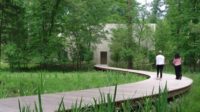Glenstone Expands With Pavilion For Richard Serra




Glenstone, the bucolic art museum 15 miles outside of Washington, D.C., is building a new pavilion to house one of Richard Serra’s most recent large-scale steel sculptures. The 4,000-square-foot structure is expected to open next spring or summer. Its design is a collaboration between Serra and architect Thomas Phifer, whose New York firm Thomas Phifer and Partners expanded the private Maryland museum in 2018, adding 12 concrete pavilions clustered around a central water court. The complex, embedded in the property’s verdant hillside, represents only a sliver of Glenstone’s 230 pastoral acres that have been enhanced over the years with 8,000 new trees and other plantings, by Adam Greenspan, design partner of the Berkeley-based PWP Landscape Architecture.

Photo © The Boundary, courtesy of the Glenstone Museum
The new pavilion will resemble Phifer’s previous volumes of large prefabricated concrete blocks, with open ¼ inch joints, but instead use poured-in-place concrete with plywood forms. Both artist and architect favored concrete: “its sense of permanence and honesty seemed to resonate with both Richard and me,” says Phifer.
As you enter the one-room skylit space with a 9-foot high ceiling, “You will come from the daylight, and then go through this moment of shade and shadow, and back into the light” says Phifer. Unlike the rest of the museum, it will have no heating, no air-conditioning, no windows, no artificial light—only skylights and natural ventilation.
Glenstone’s founders, and partners, Mitchell and Emily Rales wanted “an extremely unique experience,” the architect says. One of Serra’s works, the spiraling, weathered steel “Sylvester” already stands near the museum’s entrance. Another steel piece of Serra’s, “Contour 290”, is placed by the Woodland Trail. Visitors will approach the new pavilion by way of the trail on the eastern side of the property, following a gently curved path past a bridge over Greenbriar Stream. About a 5- minute walk from the museum, the path culminates with the minimalist volume surrounded by trees. Phifer notes, “The building will be a poetic clearing in the woods.”






